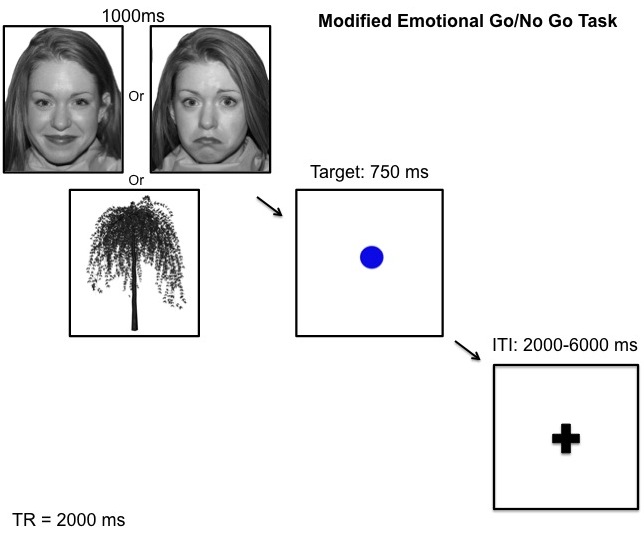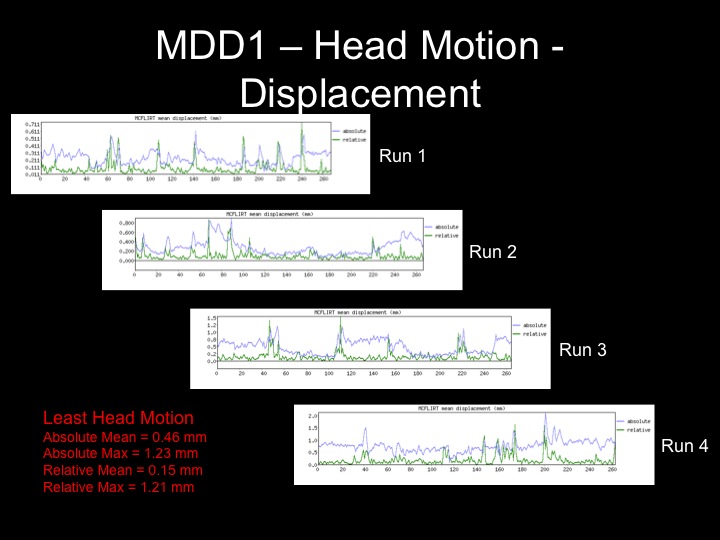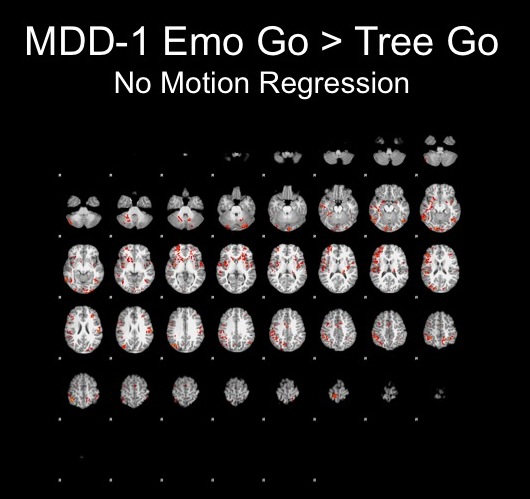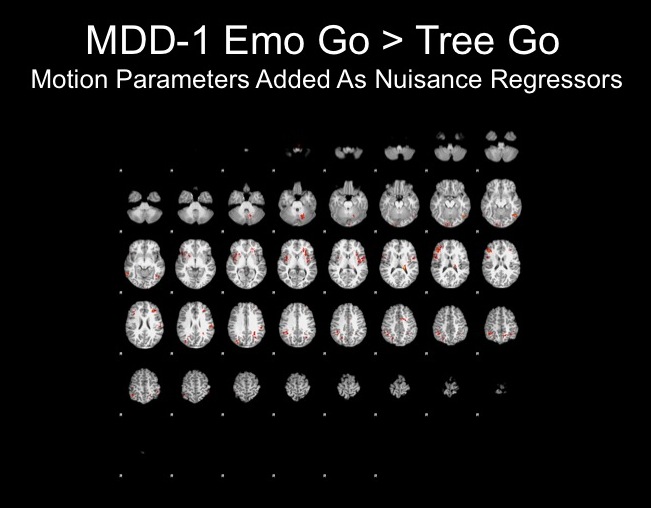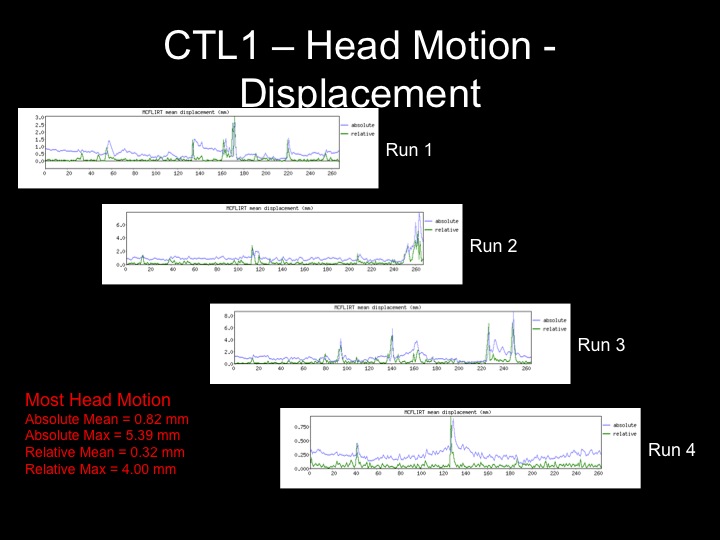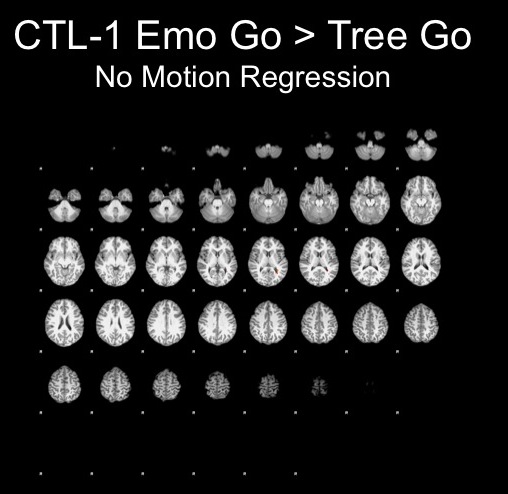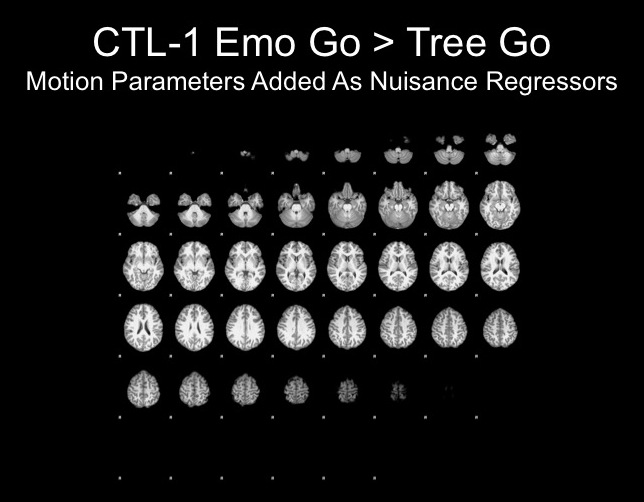Natalie: Difference between revisions
imported>Psych204B |
imported>Psych204B |
||
| Line 57: | Line 57: | ||
'''GLM Results with and without motion parameters as nuisance regressors''' | |||
[[File:MDD-1 EmoGo-TreeGo NoMoOut.jpg]] | [[File:MDD-1 EmoGo-TreeGo NoMoOut.jpg]] | ||
Revision as of 14:12, 15 March 2012
Back to Psych 204 Projects 2009
Background
Major depressive disorder (MDD) affects nearly 20% of all Americans and is the most common of all psychiatric disorders (Kessler & Wang, 2009). MDD affects about 9% of all US children and adolescents (Avenevoli, 2008), significantly altering the developmental trajectory of millions of Americans. Not only does this disorder affect individuals’ development, but it also continues later into life; in fact, 40% of depressed adolescents have a subsequent episode of depression within three years (Kessler et al., 2001), and most depressed individuals experience recurrent episodes throughout adulthood (Lewinsohn et al., 1998; Rao, Hammen, & Daley, 1999; Weissman et al., 1999). Many negative consequences of early onset depression persist into adulthood, including impairments in academic and occupational performance, interpersonal relationships, quality of life, physical well-being, and reports of life satisfaction (Lewinsohn et al., 2003). These findings clearly highlight the need to gain a more comprehensive and complete understanding of the etiology and course of this disorder in adolescence.
Early onset of depression in adolescence is of particular importance because of the emotional lability that characterizes this stage of development (Arnett, 1999). Adolescents typically report experiencing more extreme emotions (particularly negative) than do both younger children and adults (Larson & Richards, 1994). The results of neuroimaging studies provide a plausible mechanism for this emotional reactivity in adolescence: heightened subcortical limbic activation and attenuated prefrontal cortex regulation in response to emotional stimuli (Galvan et al., 2006; Guyer et al., 2008; Monk et al., 2003). This imbalance between matured emotional processing in the limbic system and an underdeveloped pre-frontal cognitive control system may underlie a number of typical adolescent behaviors such as risk-taking and emotional reactivity. For most adolescents, however, this imbalance in neural systems does not result in a clinical life-long disorder. Therefore, it is imperative that we systematically examine these systems, both behaviorally and neurologically, in order to understand the departure from typical adolescent development that predisposes individuals to MDD.
One mechanism of cognitive control that may contribute to negative attention biases observed in depressed individuals is an impairment in inhibitory functioning. The difficulty experienced by depressed individuals in inhibiting negative or sad material in the environment, combined with their selective attention to negative stimuli, can lead to alterations in mood state and negative affect, initiating or sustaining a depressive episode (Joormann, Yoon, & Zetsche, 2007). If inhibitory dysfunction is a critical factor in the etiology and maintenance of rumination and negative mood states, then differences between individuals with and without MDD should be apparent in cognitive inhibition tasks, such as the Go/No-Go task (GNG). The GNG task requires the participant to respond to a selected “go” target, presented more than 75% of the time, while overriding the prepotent response when presented with the “no-go” target (Casey et al., 1997). Given the difficulties of depressed youth in inhibiting the processing of negative stimuli, the GNG task can be adapted to examine the inhibition of emotionally salient stimuli.
Prior research suggests that inhibitory function has a protracted development throughout childhood, with individuals not reaching full capacity on inhibitory tasks, such as the Stroop, flanker, or classic GNG tasks until adolescence (Levin, et al., 1991). Researchers have attributed this impaired task performance in childhood to more extensive activation in the dorsal and lateral prefrontal cortex (PFC), suggesting that children are less efficient than are adults and need to activate more cortex in order to achieve the same level of cognitive control (Casey et al., 1997; Durston et al., 2002). Adolescents have been found to differ significantly from both children and adults in their performance emotional GNG tasks. Hare et al. (2008) examined inhibitory control in these three age groups as participants completed a GNG task with fearful, happy, and calm facial expressions as targets and non-targets. They found increased amygdala activation in adolescents relative to both children and adults, supporting the formulation that adolescence is a period during which there is immature top-down control over more mature bottom-up emotional processing. Furthermore, Hare et al. also found a negative correlation between a self-report measure of trait anxiety and activity in the ventral PFC, suggesting the subcortical limbic system and prefrontal executive control systems play a role in the development of affective symptoms.
To date, no studies have examined the neural components of inhibitory processing during an emotional GNG task in adolescents who are currently experiencing a major depressive episode. In the present study we will use an emotion-modified GNG task to examine the neural correlates of inhibitory behavior in adolescents diagnosed with MDD. Either an emotional face or an emotionally neutral tree will be presented for 1 s before the target, allowing for an examination of the effects of emotional processing on inhibitory control. Presenting the emotional face prior to the response target will permit the separation of the effects of emotional processing from those of inhibitory control.
Once you upload the images, they look like this. Note that you can control many features of the images, like whether to show a thumbnail, and the display resolution.

Methods
Task Design
The modified GNG task requires participants to make a button press when they see the visual target “go” cue (a blue circle) and inhibit this response when they see the infrequently presented “no-go” cue (a blue square). The target cue is presented approximately 70% of the time, creating a prepotent response tendency that must be inhibited in the presence of the “no-go” cue. In order to assess inhibitory function in the presence of emotional stimuli, we modified the traditional GNG task by presenting either an emotional face picture or a neutral tree picture immediately before the target or non-target cue.
Subjects
Subjects were 2 teens with MDD, 1 control teen.
MR acquisition
All scans will be conducted on a 3 Tesla GE whole-body scanner at Stanford’s Lucas Center. Foam padding was used to minimize head movement. Twenty-nine axial slices were taken with 4-mm slice thickness. High-resolution T2-weighted fast spin echo structural images (TR=3000ms, TE=68ms, ETL=12, FOV=22cm, 192x256) were acquired for anatomical reference. A T2*-sensitive gradient echo spiral in/out pulse sequence were used for functional imaging (TR =2000ms, TE=30ms, flip angle=80°, FOV=22cm, nframes=280, disdaqs=4, scan time=9.26, 4 repeats). An automated high-order shimming procedure, based on spiral acquisitions, was used to reduce B0 heterogeneity. Additional high-resolution images were acquired with an axial 3D FSPGR sequence for T1 contrast (140 slices, 1.3mm thickness, TR=6.0ms, TE=1.2ms, TI=500ms, flip angle 11°, FOV=24cm, 192x256). The axial 3D FSPGR image acquisition were repeated and the two scans were averaged after image coregistration off-line to improve SNR.
MR Analysis
The MR data was analyzed using fsl (http://www.fmrib.ox.ac.uk/fsl/).
Pre-processing
All data were motion corrected (MCFLIRT), skull stripped (BET) and a high pass filter was performed on all functional data. The four task runs were combined in a fixed effects model. All contrasts below are thresholded at Z=1.7, uncorrected for multiple comparisons.
Methods of Motion Correction
On the first subject with minimal motion, I explored the effect of adding the 6 motion parameters (x,y,z,pitch,yaw,roll), to the design matrix, as nuisance regressors.
On the second subject with an inordinate amount of motion, I not only attempted to correct for motion by regressing out the 6 motion parameters, but also attempted to remove spikes by removing the affected volumes, and also tried to correct for motion spikes by adding nuisance regressors where those spikes occurred.
Results
GLM Results for a Subject with Minimal Motion
Head displacement across the timecourse for 1 subject:
GLM Results with and without motion parameters as nuisance regressors
GLM Results for a Subject with Significant Motion
Motion Plots:
GLM Results with and without motion parameters as nuisance regressors
Retinotopic models in individual subjects transformed into MNI space
Some text. Some analysis. Some figures.
Retinotopic models in group-averaged data on the MNI template brain
Some text. Some analysis. Some figures. Maybe some equations.
Equations
If you want to use equations, you can use the same formats that are use on wikipedia.
See wikimedia help on formulas for help.
This example of equation use is copied and pasted from wikipedia's article on the DFT.
The sequence of N complex numbers x0, ..., xN−1 is transformed into the sequence of N complex numbers X0, ..., XN−1 by the DFT according to the formula:
where i is the imaginary unit and is a primitive N'th root of unity. (This expression can also be written in terms of a DFT matrix; when scaled appropriately it becomes a unitary matrix and the Xk can thus be viewed as coefficients of x in an orthonormal basis.)
The transform is sometimes denoted by the symbol , as in or or .
The inverse discrete Fourier transform (IDFT) is given by
Retinotopic models in group-averaged data projected back into native space
Some text. Some analysis. Some figures.
Conclusions
Here is where you say what your results mean.
References
Software
Appendix I - Code and Data
Code
Data
Appendix II - Work partition (if a group project)
Brian and Bob gave the lectures. Jon mucked around on the wiki.
